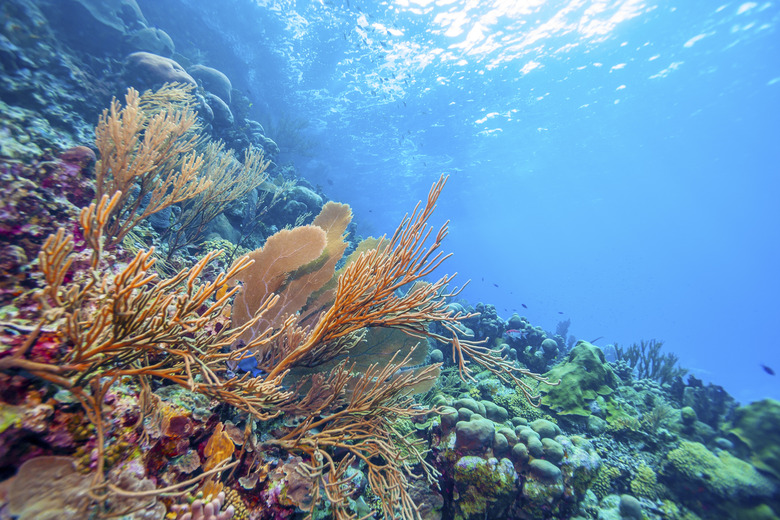What Are Interesting Facts About The Marine Biome?
The marine/saltwater biome dominates the surface of the Earth with oceans, coral reefs and estuaries covering about three-quarters of the Earth's surface area. The world's oceans contain the richest diversity of species of any space on Earth, while marine algae absorb a large amount of the atmospheric carbon dioxide and provide the majority of the Earth's oxygen supply. Rainwater for land areas is supplied by the evaporation of ocean waters.
Background to Facts about the Marine Ecosystem
Background to Facts about the Marine Ecosystem
According to the University of California Museum of Paleontology, biomes are the "world's major communities" and are characterized by the specific way living things adapt to each environment.
The Earth is made up of six types of biomes:
1. Marine 2. Freshwater 3. Desert 4. Forest 5. Grassland 6. Tundra
The marine biome is by far the largest. Water has a very large capacity for heat, which means that the vast oceans play a vital role in keeping the Earth's temperature fairly constant. In addition, the several billion photosynthetic plankton provide most of the photosynthesis for the planet.
The marine biome is also where scientists believe that life first originated over 3 billion years ago. The first fossils showing evidence of life date back to around 3.7 billion years ago showing marine stromatolites in a fossil found in Western Australia. Life didn't make its way to land until around 440 million years ago in the form of very simple bacteria-like and fungi-like organisms, but it likely prospered for millions (and billions) of years in the oceans.
Ecosystems
Ecosystems
The marine biome is divided into three distinct ecosystems: oceans, coral reefs and estuaries.
The oceans, which include the Pacific, Atlantic, Indian, Southern and Arctic Oceans, are interconnected and cover about 71 percent of the Earth's surface. In some areas, the ocean is deeper than the world's highest mountains. For instance, the Mariana Trench in the Pacific Ocean reaches depths of about 32,800 feet.
Coral reefs are located in warm, shallower waters, and are primarily made up of corals, which are a combination of algae and animal polyp. Numerous fish, sea urchins, invertebrates, microorganisms and other living things inhabit coral reefs.
Estuaries are those areas where freshwater streams or rivers meet the ocean. Estuaries support many types of species, including oysters, crabs, waterfowl and macroflora such as seaweed and marsh grasses.
Marine Biome Animals and Organisms
Marine Biome Animals and Organisms
The world's marine ecosystems are home to an astounding variety of species ranging from the microscopic phytoplankton and zooplankton to the largest mammal ever to have lived on the Earth: the 200-ton blue whale. Marine biome animals include a vast array of fish species, including flounder, mackerel, butterfish, spiny dogfish, squid, monkfish and others. Many birds, such as shorebirds, gulls, terns and wading birds, call the marine ecosystem their home. Coral reefs are home to some of the largest diversity of marine species anywhere on the planet.
Unique Features and Facts about the Marine Ecosystem
Unique Features and Facts about the Marine Ecosystem
According to the U.S. Environmental Protection Agency, there is a unique feature about saltwater ecosystems that separate them from other ecosystems. That is the presence of dissolved compounds – especially salts and chlorine – in ocean waters. The dissolved compounds give seawater a salty taste, prevent oceans from freezing in cold weather and affect the overall composition of species in specific habitats.
Organisms like marine biome animals that live in this saltwater biome must adapt to variations in salt levels as a result of changes in climate and the influence of freshwater from rivers, streams and estuaries. Among those organisms that have developed the capability to adapt to changing salt levels are mussels, clams and barnacles.
Cite This Article
MLA
Arvidson, Erik. "What Are Interesting Facts About The Marine Biome?" sciencing.com, https://www.sciencing.com/interesting-marine-biome-8615636/. 22 November 2019.
APA
Arvidson, Erik. (2019, November 22). What Are Interesting Facts About The Marine Biome?. sciencing.com. Retrieved from https://www.sciencing.com/interesting-marine-biome-8615636/
Chicago
Arvidson, Erik. What Are Interesting Facts About The Marine Biome? last modified March 24, 2022. https://www.sciencing.com/interesting-marine-biome-8615636/
